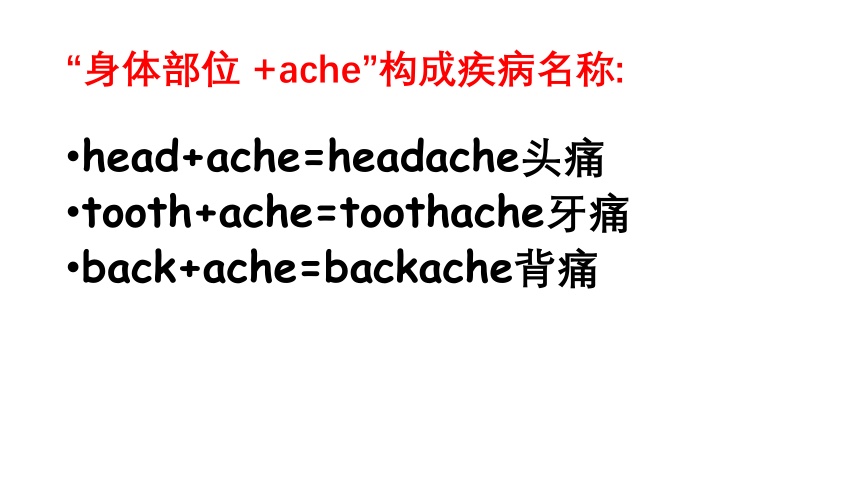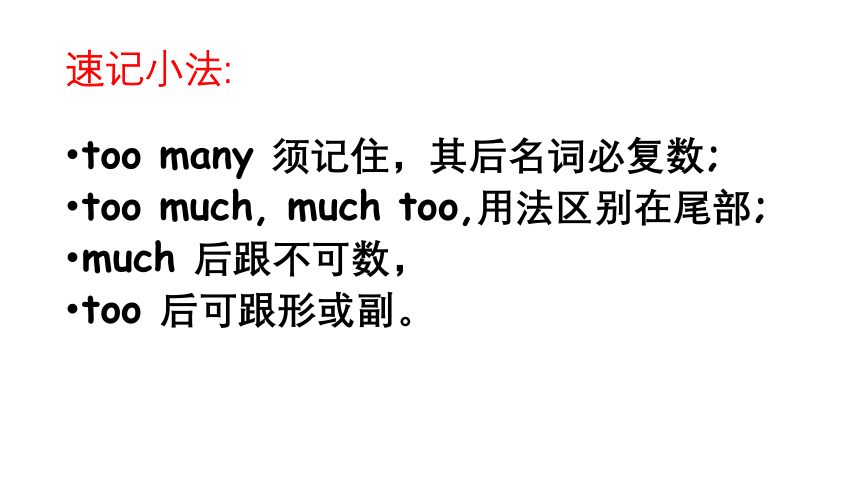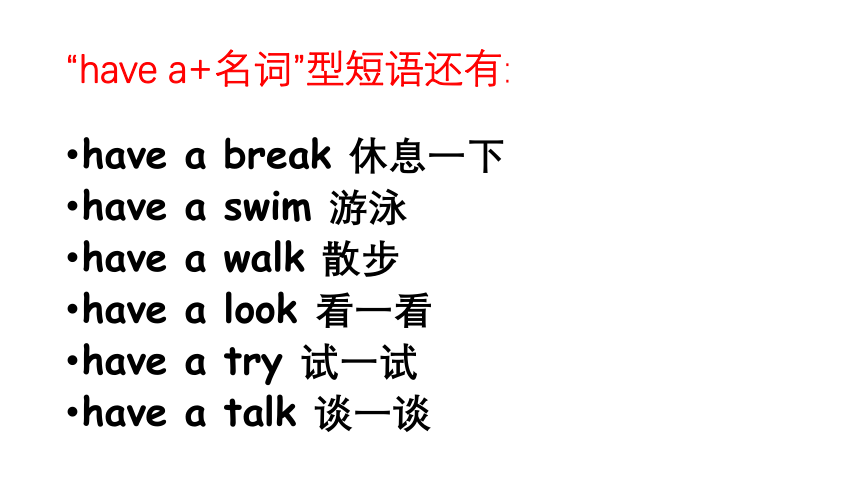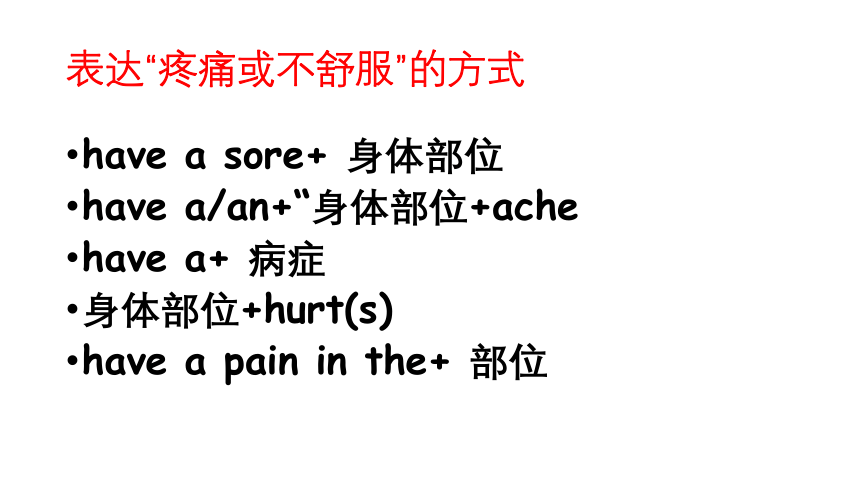Unit 1 What's the matter?Section A 词汇讲解课件(共有PPT13张)
文档属性
| 名称 | Unit 1 What's the matter?Section A 词汇讲解课件(共有PPT13张) |  | |
| 格式 | zip | ||
| 文件大小 | 67.6KB | ||
| 资源类型 | 教案 | ||
| 版本资源 | 人教新目标(Go for it)版 | ||
| 科目 | 英语 | ||
| 更新时间 | 2022-02-25 11:19:06 | ||
图片预览






文档简介
(共13张PPT)
“(你)怎么了 ”各种常见表达归纳:
①What's the matter (with you)
② What's the trouble (with you)
③ What's the problem (with you)
④ What 's wrong (with you)
⑤ What 's up ( with you )
⑥ What happened ( to you )
⑦Is there anything wrong( with you )
“身体部位 +ache”构成疾病名称:
head+ache=headache头痛
tooth+ache=toothache牙痛
back+ache=backache背痛
速记小法:
too many 须记住,其后名词必复数;
too much, much too,用法区别在尾部;
much 后跟不可数,
too 后可跟形或副。
“have a+名词”型短语还有:
have a break 休息一下
have a swim 游泳
have a walk 散步
have a look 看一看
have a try 试一试
have a talk 谈一谈
lie 的一词多义 VS lay
lie-lay-lain-lying 躺
lie-lied-lied-lying说谎
lay-laid-laid-laying放置/下蛋
lay为躺的过去式,放置/下蛋的原形
表达“疼痛或不舒服”的方式
have a sore+ 身体部位
have a/an+“身体部位+ache
have a+ 病症
身体部位+hurt(s)
have a pain in the+ 部位
Get 的词组
get on 上(公共汽车)
get off 下(公共汽车)
get into 上(小汽车)
get out of 下(小汽车)
to one's+表示感彩的名词
“令/使某人…的是"
to one 's joy/happiness令/使某人高兴的是…
to one 's disappointment令/使某人失望的是…
to one's shame令某人羞愧的是…
to one s satisfaction令/使某人满意的是…
trouble 常用词组
get into trouble陷入困境
have trouble / difficulty/problems with sth. =
have trouble /difficulty! problems(in) doing sth.
做某事有困难
ask for trouble 自寻烦恼
in trouble 陷入困境
一语辨异
Don't trouble trouble until trouble troubles you.
麻烦没来找你,不要自找麻烦.
hit的用法
表示“打某人/某物某个部位”
hit sb./sth. on/in the+ 部位。
小贴士:打在人体硬部位上用介词on,
软部位上用介词in,
且结构中的定冠词 the 通常
不可用物主代词 my,his 等代替。
right away的同义词和
同义短语
﹛
immediately
right now/
at once.
【重点】反身代词的常用短语:
teach oneself=learn by oneself 自学
enjoy oneself 过得愉快
help oneself to…. 随便吃/用……
look after oneself 照顾某人自己
dress oneself 给自己穿衣服
“(你)怎么了 ”各种常见表达归纳:
①What's the matter (with you)
② What's the trouble (with you)
③ What's the problem (with you)
④ What 's wrong (with you)
⑤ What 's up ( with you )
⑥ What happened ( to you )
⑦Is there anything wrong( with you )
“身体部位 +ache”构成疾病名称:
head+ache=headache头痛
tooth+ache=toothache牙痛
back+ache=backache背痛
速记小法:
too many 须记住,其后名词必复数;
too much, much too,用法区别在尾部;
much 后跟不可数,
too 后可跟形或副。
“have a+名词”型短语还有:
have a break 休息一下
have a swim 游泳
have a walk 散步
have a look 看一看
have a try 试一试
have a talk 谈一谈
lie 的一词多义 VS lay
lie-lay-lain-lying 躺
lie-lied-lied-lying说谎
lay-laid-laid-laying放置/下蛋
lay为躺的过去式,放置/下蛋的原形
表达“疼痛或不舒服”的方式
have a sore+ 身体部位
have a/an+“身体部位+ache
have a+ 病症
身体部位+hurt(s)
have a pain in the+ 部位
Get 的词组
get on 上(公共汽车)
get off 下(公共汽车)
get into 上(小汽车)
get out of 下(小汽车)
to one's+表示感彩的名词
“令/使某人…的是"
to one 's joy/happiness令/使某人高兴的是…
to one 's disappointment令/使某人失望的是…
to one's shame令某人羞愧的是…
to one s satisfaction令/使某人满意的是…
trouble 常用词组
get into trouble陷入困境
have trouble / difficulty/problems with sth. =
have trouble /difficulty! problems(in) doing sth.
做某事有困难
ask for trouble 自寻烦恼
in trouble 陷入困境
一语辨异
Don't trouble trouble until trouble troubles you.
麻烦没来找你,不要自找麻烦.
hit的用法
表示“打某人/某物某个部位”
hit sb./sth. on/in the+ 部位。
小贴士:打在人体硬部位上用介词on,
软部位上用介词in,
且结构中的定冠词 the 通常
不可用物主代词 my,his 等代替。
right away的同义词和
同义短语
﹛
immediately
right now/
at once.
【重点】反身代词的常用短语:
teach oneself=learn by oneself 自学
enjoy oneself 过得愉快
help oneself to…. 随便吃/用……
look after oneself 照顾某人自己
dress oneself 给自己穿衣服
同课章节目录
- Unit 1 What's the matter?
- Section A
- Section B
- Unit 2 I'll help to clean up the city parks.
- Section A
- Section B
- Unit 3 Could you please clean your room?
- Section A
- Section B
- Unit 4 Why don't you talk to your parents?
- Section A
- Section B
- Unit 5 What were you doing when the rainstorm came
- Section A
- Section B
- Review of Units 1-5
- Unit 6 An old man tried to move the mountains.
- Section A
- Section B
- Unit 7 What's the highest mountain in the world?
- Section A
- Section B
- Unit 8 Have you read Treasure Island yet?
- Section A
- Section B
- Unit 9 Have you ever been to a museum?
- Section A
- Section B
- Unit 10 I've had this bike for three years.
- Section A
- Section B
